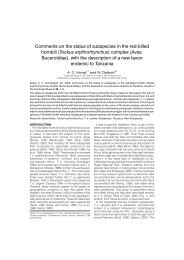EAZA Hornbill Management and Husbandry Guidelines
EAZA Hornbill Management and Husbandry Guidelines
EAZA Hornbill Management and Husbandry Guidelines
Create successful ePaper yourself
Turn your PDF publications into a flip-book with our unique Google optimized e-Paper software.
Foreword<br />
How to use these guidelines<br />
The compilation of these guidelines started in 1996 with the distribution of the EEP Great<br />
<strong>Hornbill</strong> <strong>Management</strong> <strong>and</strong> Husb<strong>and</strong>ry Questionnaire. Eighty-five percent of the 55<br />
questionnaires sent to European <strong>and</strong> American zoos was completed <strong>and</strong> the resulting report<br />
(Galama, 1996b) was presented during the second International <strong>Hornbill</strong> Workshop 1997 in<br />
Malaga (Spain), organized by the <strong>EAZA</strong> <strong>Hornbill</strong> TAG <strong>and</strong> the Buceros bicornis EEP species<br />
committee. An international group of knowledgeable people working with hornbills in the<br />
field or in zoological institutions discussed <strong>and</strong> summarized suggestions for keeping <strong>and</strong><br />
breeding hornbills successfully in captivity. As promised, but with quite a delay, the<br />
suggestions made during the International <strong>Hornbill</strong> Workshop, as well as other information<br />
that has become available in the interim, can now be shared with others through this<br />
document: The <strong>EAZA</strong> <strong>Hornbill</strong> Husb<strong>and</strong>ry <strong>and</strong> <strong>Management</strong> <strong>Guidelines</strong>, First Edition, 2002.<br />
Successful breeding of most captive hornbills remains a challenge, <strong>and</strong> the scarce information<br />
available is scattered over the world. Therefore, the guidelines must be seen as a working<br />
document that tries to arrange known pieces of the puzzle. Because we wanted to construct<br />
the guidelines so that the user only (usually) needs to refer to one section to answer a<br />
question, some pieces of information appear more than once in the guidelines. Other sections<br />
of the guideline are referred to if they give more or different information regarding a subject.<br />
Hopefully, the guidelines will help to improve hornbill husb<strong>and</strong>ry <strong>and</strong> management <strong>and</strong> will<br />
inspire the user to document new findings <strong>and</strong> to also make these available to others. The<br />
<strong>EAZA</strong> <strong>Hornbill</strong> TAG is planning to produce a revision of the guidelines in 2004. We hope<br />
that users will send data, comments, suggestions <strong>and</strong> corrections on this first/draft version to<br />
the <strong>EAZA</strong> <strong>Hornbill</strong> TAG chair Koen Brouwer for incorporation into the revision. That<br />
version will hopefully be available via internet.




